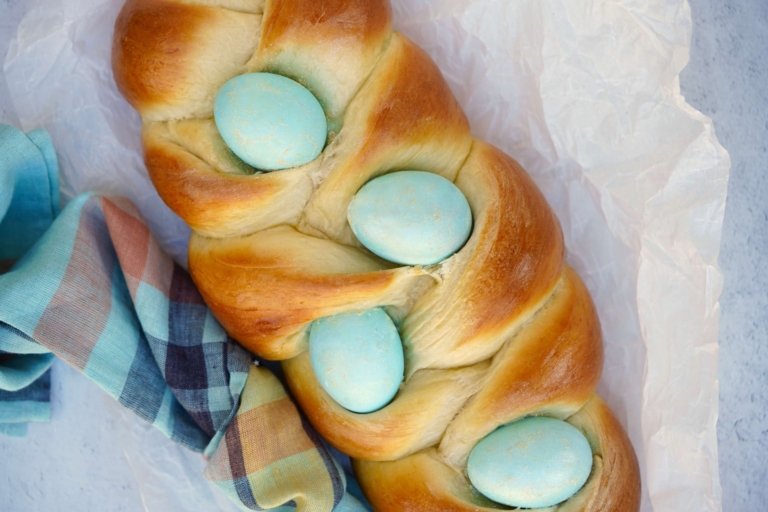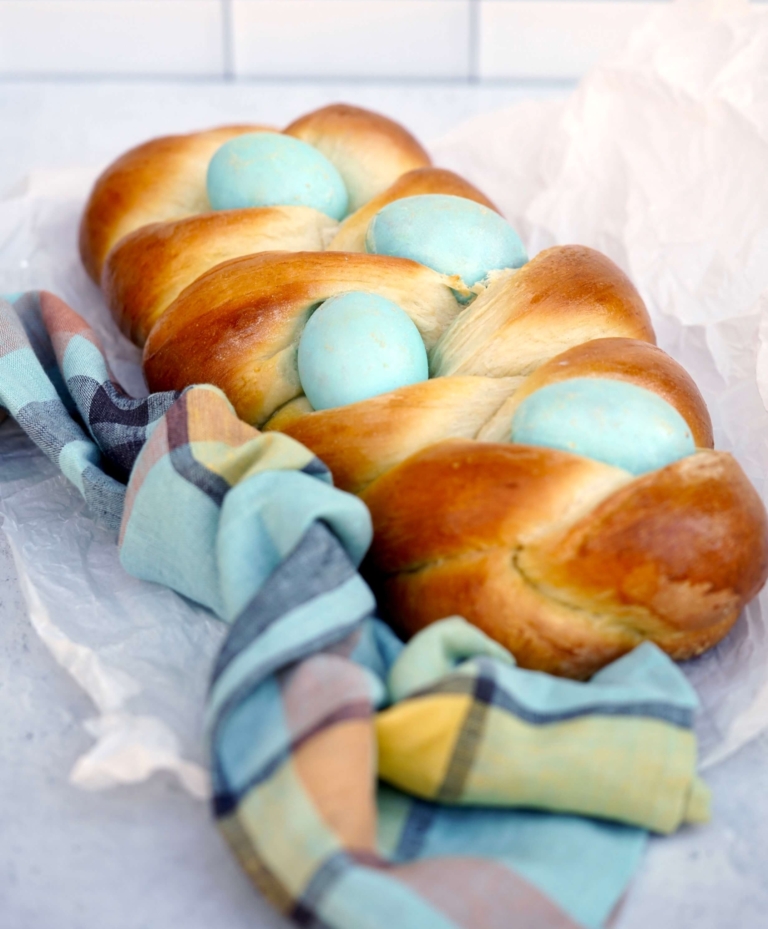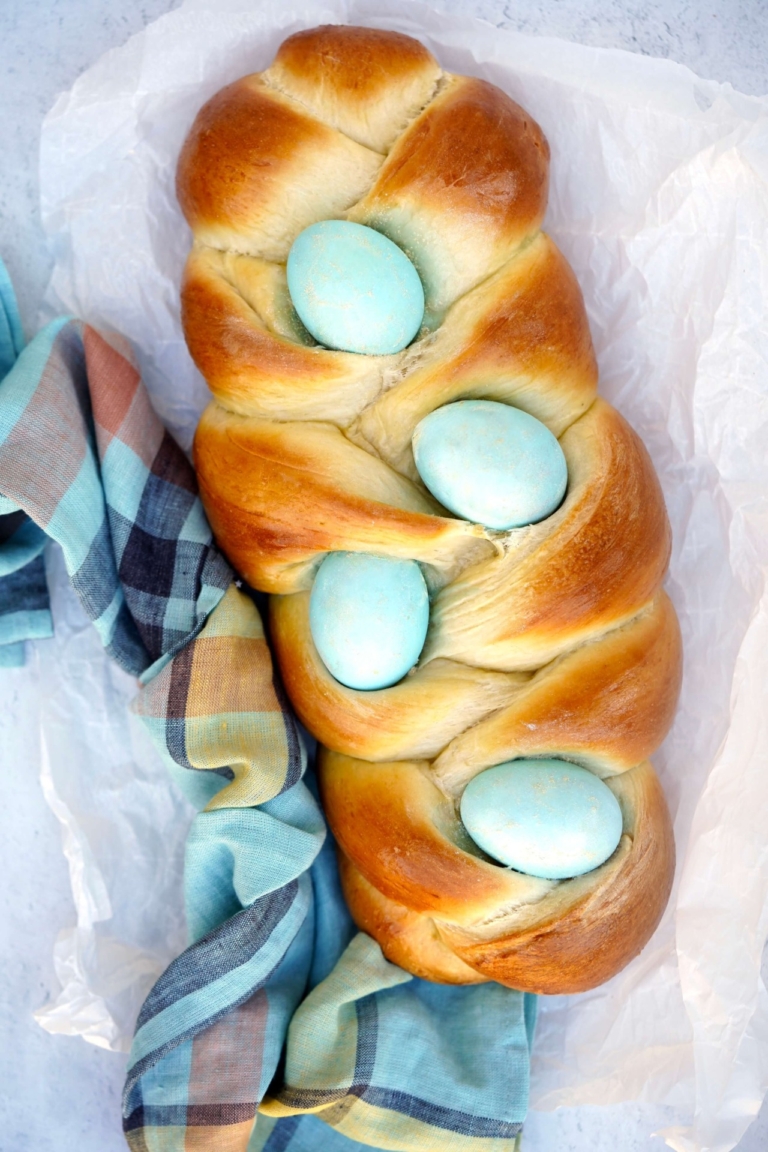Italian Easter Bread

The first thing my boys said to me when I made Easter bread for the first time, was; why the heck are you baking Easter eggs into the challah? Those, are Jewish kids for you. I had a good laugh, but in fairness to them, I get it. When you break it down, Easter bread sure does look, and taste, an awful lot like challah bread.
The Origin of Easter Bread
Easter bread is made from a sweetened, yeasted dough, that’s formed into wreaths or braided, with colored eggs (that you don’t eat) baked into the dough and often topped with colorful nonpareils. The Italians love to celebrate holidays with food and Easter is one of those special holidays. Easter is preceded by Lent, a time of fasting for many Christians. Come Easter Sunday, it is time to celebrate, splurge and indulge.
Greeks also make an Easter bread called “tsoureki“. Typically tsoureki is made on Good Thursday but you don’t eat it before the end of Saturday because, in religious practices, in the days leading up to Easter Sunday, you shouldn’t be eating dairy products. Tsoureki is very similar to Jewish challah bread or French brioche because the basic ingredients are the same. The difference is that tsoureki uses a spice called mahlepi, which is made from the seeds found inside a type of cherry stone. That spice, when cooked, gives the bread a sweet smell and distinct taste.
Easter bread has a long history associated with it that I find fascinating. Religion aside, this festive and fun yeast bread is truly considered an Easter favorite around the globe. Although the permutations are endless, I prefer to make my Easter bread a bit more muted and absent of the decadent frosting and sprinkles I have seen on so many.
This recipe is not mine, it is a lightly adapted version from one I read about in Bon Appetite. The original recipe can be seen here. And if you have never tried making an Easter bread before, it’s a worthy holiday bread that is not too time-consuming and makes a lovely addition to any Easter celebration.
Italian Easter Bread
Ingredients:
For the Dough:
- 2/3 cup whole milk
- 5 tablespoons sugar, divided
- 1 3/4 teaspoons active dry yeast
- 2 eggs, room temperature
- 2 3/4 cups all-purpose flour
- 1 teaspoon kosher salt
- 1/2 cup unsalted butter, cut into 1-inch pieces, room temperature, plus 1/2 tablespoon, melted
For the Eggs:
- 4-5 eggs
- Food coloring (optional)
Directions:
- For the Dough: In a small saucepan, add the milk, place over medium heat, and cook until an instant-read thermometer registers 110–115 degrees F. Transfer the milk to a 2-cup measuring cup, and add 1 tablespoon of sugar. Sprinkle the yeast over milk and whisk to blend. Cover and let sit until the yeast is foamy, about 5 minutes. Add the eggs, one at a time, and whisk until smooth and blended.
- In the bowl of a kitchen mixer, add the remaining 4 Tablespoons of sugar, flour, and salt in the bowl of a stand mixer fitted with a dough hook. Add the milk mixture. With the mixer running, add 1/2 cup room-temperature butter, a little at a time, blending well between additions. Mix on medium speed for about 1 minute. Knead on medium-high speed until dough is soft and silky, about 5 minutes.
- Brush a medium bowl with some melted butter and place the dough in the bowl. Brush the top of the dough with the remaining melted butter, and cover it with plastic wrap. Let the dough rise in a warm, draft-free area until it has doubled in size, about 1–1 1/2 hours.
- For the Eggs: Place 4-5 eggs in a medium sauce pot. Cover the eggs with cold water by 1 inch and bring to a boil over medium-high heat. Remove from heat, cover the pot, and let stand for 10 minutes. Transfer eggs to a medium bowl of ice water and allow to cool completely.
- If desired, color the eggs according to the food-coloring package directions. Transfer eggs to paper towels to dry. Cover and chill until needed.
- Line a large baking sheet with parchment paper. Punch down the dough. Divide into 3 equal pieces. With lightly floured hands, roll each piece on a lightly floured surface into a 16-inch-long rope with tapered ends. Arrange ropes side by side lengthwise on the prepared sheet. Pinch the top ends together. Braid the dough. Pinch the bottom ends together to secure (a braided loaf will be about 12 inches long). Tuck the dyed eggs between braids, spacing evenly. Loosely cover with plastic wrap or a kitchen towel. Let rise in a warm, draft-free area until puffed but not doubled in size, about 1 hour.
- Preheat to 375 degrees F. In a small mixing bowl, whisk the remaining egg with 2 teaspoons of warm water. Using a pastry brush, and avoiding the dyed eggs, brush the dough all over with egg wash. Place in the oven and bake, rotating once, until the bread is golden, about 20–25 minutes. Let the bread cool on a wire rack. Serve the bread warm or at room temperature.




